
JOURNAL OF MONEY CREDIT AND BANKING
Scope & Guideline
Illuminating the Interplay of Money and Markets
Introduction
Aims and Scopes
- Monetary Policy Analysis:
The journal extensively covers topics related to the formulation, implementation, and impact of monetary policy, particularly in low-interest-rate environments and unconventional monetary policies. - Banking Systems and Financial Stability:
Research often explores the role of banking institutions in the economy, focusing on stability, risk management, and the impact of regulatory frameworks on financial performance. - Credit Markets and Economic Dynamics:
Key studies analyze the behavior of credit markets, including lending practices, credit cycles, and the effects of credit constraints on economic growth and development. - Macroeconomic Interactions:
The journal frequently publishes articles that investigate the interactions between macroeconomic variables such as inflation, employment, and output, providing insights into their implications for monetary and fiscal policy. - Behavioral Economics in Finance:
A growing area of interest involves the incorporation of psychological factors into financial decision-making, particularly how consumer behavior and expectations influence economic outcomes.
Trending and Emerging
- Digital Currencies and Financial Technology:
There is an increasing focus on the implications of digital currencies, including cryptocurrencies, and the role of financial technology in reshaping monetary policy and banking practices. - Impact of Macroeconomic Uncertainty:
Recent studies emphasize the effects of macroeconomic uncertainty on consumer behavior, credit markets, and overall economic stability, highlighting the importance of understanding uncertainty in policy formulation. - Behavioral Insights into Monetary Policy:
Emerging research integrates behavioral economics into the analysis of monetary policy effectiveness, exploring how psychological factors influence consumer and investor responses to policy changes. - Climate Change and Monetary Policy:
An emerging area of research investigates the intersection of climate change and monetary policy, focusing on how environmental factors can influence financial stability and economic growth. - Heterogeneous Effects of Policy Measures:
A trend towards exploring how monetary and fiscal policy measures affect different sectors and demographics differently is gaining momentum, reflecting a more nuanced approach to policy analysis.
Declining or Waning
- Traditional Banking Models:
Research that strictly adheres to classical banking models has become less frequent as newer theories and empirical analyses that incorporate behavioral and structural complexities gain traction. - Currency and Exchange Rate Stability:
While still relevant, there appears to be a waning interest in studies solely focused on currency stability and exchange rate mechanisms, as attention shifts towards digital currencies and their implications. - Static Economic Models:
There is a noticeable decrease in papers that utilize static models without considering dynamic factors or uncertainties, reflecting a broader trend towards more complex and realistic modeling approaches.
Similar Journals
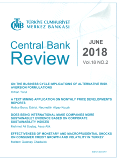
Central Bank Review
Fostering innovation in central banking scholarship.Central Bank Review is a leading journal published by the CENTRAL BANK REPUBLIC TURKEY, dedicated to advancing the field of economics and finance. With an ISSN of 1303-0701 and an E-ISSN of 1305-8800, this open-access journal has been serving the academic community since 2016, providing a rich source of knowledge for researchers, professionals, and students alike. The journal focuses on a diverse range of topics within economics, econometrics, and finance, making it a valuable resource for those looking to stay at the forefront of these rapidly evolving fields. Notably, in 2023, it achieved a Q2 ranking in both Economics and Econometrics and Finance, highlighting its relevance and impact within the academic community, with Scopus rankings placing it in the top quartile of its categories. Central Bank Review not only contributes to rigorous academic discourse but also offers insights and policy discussions pertinent for central banking and economic policy, solidifying its importance in shaping the future of economic research. Located in the Netherlands, this journal provides easy access to its published articles, ensuring that vital research reaches readers globally.
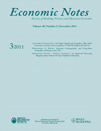
Economic Notes
Contributing to the Evolution of Economic ScholarshipEconomic Notes is a peer-reviewed journal published by WILEY, focusing on the dynamic field of economics and econometrics. With an ISSN of 0391-5026 and an E-ISSN of 1468-0300, this esteemed journal offers a platform for researchers, professionals, and students to explore theoretical advancements, empirical studies, and policy implications within the economic landscape. Established in the United Kingdom, Economic Notes has become a noteworthy publication, currently ranked in the Q3 category in the 2023 Economics and Econometrics quartiles, and situating itself at the forefront of the field with a respectable 60th percentile ranking in Scopus. The journal spans a remarkable convergence of scholarship from 2001 to 2024, fueling academic discourse and providing insights into pressing economic issues. Although it does not provide open access options, it remains a crucial resource for those seeking to enhance their understanding and contribute to economic theory and practice.

B E Journal of Macroeconomics
Unveiling the intricacies of macroeconomic phenomena.B E Journal of Macroeconomics is a distinguished academic journal published by WALTER DE GRUYTER GMBH that serves as a critical platform for advancing the field of macroeconomic research. Established in 2001, it has gained recognition within the economics community, featuring a broad range of theories and empirical studies relevant to contemporary economic issues. With an impact factor reflective of its academic contributions, the journal is categorized in the Q3 quartile for Economics and Econometrics, ranking 607 out of 716 in its field according to Scopus metrics. The journal's scope includes a comprehensive exploration of macroeconomic trends, policy analysis, and the dynamics of economic systems, catering to researchers, practitioners, and students alike. Though primarily published in a traditional format, researchers have ample opportunities to access its invaluable content through institutional subscriptions, ensuring the dissemination of knowledge across the global economic landscape. Located in Berlin, Germany, B E Journal of Macroeconomics not only enriches the academic discourse but also fosters a deeper understanding of macroeconomic phenomena, making it an essential resource for anyone engaged in the field.
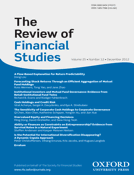
REVIEW OF FINANCIAL STUDIES
Advancing the Frontier of Financial KnowledgeREVIEW OF FINANCIAL STUDIES, published by Oxford University Press Inc, stands as a premier academic journal in the realms of accounting, economics, and finance. With an impressive Impact Factor that reflects its high citation rates and broad influence, this journal, with an ISSN of 0893-9454 and E-ISSN 1465-7368, is considered a cornerstone for researchers, academics, and professionals seeking to contribute to and stay updated on groundbreaking developments in financial studies. Since its inception in 1996, it has established a robust reputation, consistently ranking in the Q1 category across multiple disciplines, highlighting its elite status in the global academic landscape. The Scopus rankings further reinforce its importance, positioning it at the forefront of business, economics, and finance research. While the journal is not open access, it offers vital insights and comprehensive studies that foster a deeper understanding of contemporary financial issues and methodologies. Located in the United Kingdom, the REVIEW OF FINANCIAL STUDIES is an essential resource for those aiming to advance their knowledge and research in this dynamic field.

Journal of Structured Finance
Navigating Complexity in Finance with ExpertiseThe Journal of Structured Finance, published by PAGEANT MEDIA LTD, is a pivotal resource for professionals and academics engaged in the finance sector. With its ISSN 1551-9783 and E-ISSN 2374-1325, this journal explores cutting-edge concepts in structured finance, offering insights into risk management, financial derivatives, and innovative financing strategies. As of 2023, it proudly holds a Q3 ranking in the finance category, with a Scopus rank of #280 out of 317, contributing valuable perspectives in a competitive field. Operating from the United States and serving a global audience, the journal encourages research that bridges theoretical foundations and practical applications, enhancing the understanding of complex financial instruments. With no Open Access options currently available, readers can access this valuable content through institutional subscriptions or individual purchases, reaffirming its relevance and importance for researchers, professionals, and students alike who seek to navigate the dynamic world of finance.
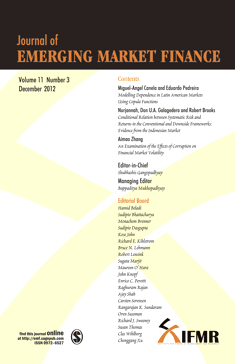
Journal of Emerging Market Finance
Charting New Frontiers in Economic AnalysisThe Journal of Emerging Market Finance, published by SAGE Publications India Pvt Ltd, is a premier academic journal that serves as a vital resource for researchers, professionals, and students in the fields of finance and economics. Established in 2002, this journal focuses on the multifaceted dynamics of emerging market economies and their financial systems. With an ISSN of 0972-6527 and an E-ISSN of 0973-0710, it has garnered attention with its respectable Q3 rankings in both the Economics and Econometrics and Finance categories, reflecting its commitment to high-quality research. Despite its limited open-access options, the journal remains a significant platform for scholarly discussions, providing insights on emerging financial instruments, market behaviors, and economic policies in developing economies. As a continuously evolving publication, it aims to bridge the gap between theory and practice, promoting an understanding of the complexities faced in these vibrant markets, ultimately serving the academic community with relevant and impactful research until 2024 and beyond.

JOURNAL OF FINANCIAL ECONOMICS
Uncovering cutting-edge studies in financial economics.Welcome to the JOURNAL OF FINANCIAL ECONOMICS, a premier publication in the realms of finance, economics, and accounting, published by Elsevier Science SA in the Netherlands. With its impactful contributions since 1974, this esteemed journal has earned an impressive impact factor and consistently ranks in the Q1 category across various fields, including Accounting, Economics and Econometrics, Finance, and Strategy and Management. Researchers can access cutting-edge studies that delve into both theoretical frameworks and empirical analyses, crucial for advancing financial literacy and economic policies globally. With remarkable Scopus rankings, notably placing #2 in Accounting and #6 in Finance, the journal serves not only as a reliable resource for academics but also as a vital tool for professionals seeking to stay abreast of the latest financial trends and insights. Engage with the latest research and contribute to the dialogue shaping the future of financial economics!
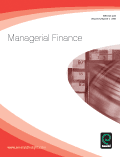
MANAGERIAL FINANCE
Bridging Theory and Practice in Financial Management.MANAGERIAL FINANCE is a prestigious academic journal published by Emerald Group Publishing Ltd, focused on the areas of finance, management, and strategy. With an ISSN of 0307-4358 and an E-ISSN of 1758-7743, this journal has carved a niche for itself within the business and financial sectors, achieving a commendable Q2 category ranking across multiple domains, including Business, Management and Accounting, Finance, and Strategy and Management, as of 2023. The journal aims to provide a platform for insightful research and critical analysis while fostering an understanding of contemporary financial practices and theories. With its wide-ranging scope, it serves as a vital resource for researchers, professionals, and students alike, looking to stay abreast of the latest trends and challenges in managerial finance. The editorial board is committed to maintaining academic rigor, ensuring that articles published are of the highest quality and relevance to the field. By bridging the gap between theory and practice, MANAGERIAL FINANCE is an essential reference for anyone involved in financial decision-making and strategic management.

Journal of Central Banking Theory and Practice
Advancing the Frontiers of Central Banking KnowledgeThe Journal of Central Banking Theory and Practice, published by SCIENDO, is a leading open-access journal that has been providing valuable insights into the realms of central banking, monetary policy, and financial stability since its inception in 2012. With its ISSN 1800-9581 and E-ISSN 2336-9205, this journal emphasizes rigorous scholarly research, catering to a wide audience of economists, finance professionals, and academic researchers. Based in Germany, the journal has established a strong reputation, evident from its improved category quartiles - moving from Q3 in Economics, Econometrics, and Finance to a commendable Q2 in 2023. With an impressive Scopus rank of #83/288 in General Economics and a 71st percentile ranking, it stands as a pivotal resource for understanding current trends and practices in central banking. Authors are encouraged to submit high-quality, original research that fosters knowledge and advances the field. This journal not only disseminates significant findings but also promotes discussions that are critical for policymakers and stakeholders in the financial sector.
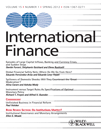
International Finance
Pioneering research at the intersection of finance and geography.International Finance is a prestigious academic journal published by WILEY, dedicated to the exploration and advancement of theories and practices in the realms of finance, development, and geography. With a strong emphasis on empirical and theoretical research, this journal provides a crucial platform for researchers, professionals, and students to disseminate cutting-edge findings that shape our understanding of the financial landscape on a global scale. Holding an impressive impact factor and categorized in the Q2 quartile across multiple disciplines, including Development, Finance, and Geography, the journal has established itself as a significant contributor to scholarly discourse. Since its inception in 1998 and spanning until 2024, International Finance offers a comprehensive overview of current trends and challenges faced in financial contexts, enhancing the decision-making processes within academia and industry alike. Although the journal is not open access, its rigorous peer-review process guarantees high-quality content that is indispensable for anyone engaged in the diverse fields intersecting with finance.